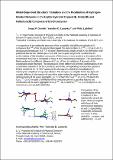Metal-dependent structural variations and the peculiarities of hydrogen-bonded networks in the highly hydrated copper(II), nickel(II) and palladium(II) complexes of bis-dioxocyclam
Abstract
The crystal structures of the copper(II) (Cu2L14B·9H2O and Cu2L14B·12H2O), nickel(II) (Ni2L14B·12H2O) and palladium(II) (Pd2L14B·12H2O) complexes of the C-C linked bis-dioxocyclam ligand have been determined by single crystal X-ray diffraction (bis-dioxocyclam, H4L14B·= 6,6'-bi-(1,4,8,11-tetraazacyclotetradecane)-5,5',7,7'-tetraone). Planar coordination environment of the metal(II) ions is formed by cis-2Namide+cis-2Namine donor atoms. Additionally, the apical site in the copper(II) complexes is occupied by the water molecule. All complex molecules adopt a ‘stretched’ conformation with intramolecular metal-metal distances ranging from 6.608 to 7.002 Å. The conformations of the macrocyclic subunits in M2L14B reveal considerable variations depending on the metal ion and differ significantly from those of the corresponding mono-macrocyclic dioxocyclam complexes ML14M (dioxocyclam, H2L14М·= 1,4,8,11-tetraazacyclotetradecane-5,7-dione) thus resembling the behavior for the open-chain analogues. A detailed analysis of the 1H NMR spectra of the diamagnetic nickel(II) and palladium(II) complexes supports preservation of the conformational differences in aqueous solution. Electronic absorption spectra and electrochemical characteristics of the M2L14B complexes are also briefly discussed. Being highly hydrated solids, the bis-macrocyclic compounds are characterized by extended networks of hydrogen bonds. The water molecules form infinite aggregates differing by the structure and dimensionality – 1D chains for Cu2L14B·9H2O, 2D layers for Cu2L14B·12H2O and Ni2L14B·12H2O, and 3D-network for Pd2L14B·12H2O.
Citation
Gavrish , S P , Lampeka , Y D & Lightfoot , P 2015 , ' Metal-dependent structural variations and the peculiarities of hydrogen-bonded networks in the highly hydrated copper(II), nickel(II) and palladium(II) complexes of bis-dioxocyclam ' , Crystal Growth & Design , vol. 15 , no. 4 , pp. 2024-2032 . https://doi.org/10.1021/acs.cgd.5b00217
Publication
Crystal Growth & Design
Status
Peer reviewed
ISSN
1528-7483Type
Journal article
Collections
Items in the St Andrews Research Repository are protected by copyright, with all rights reserved, unless otherwise indicated.

